Scientific name Pinguinus impennis Higher classification Pinguinus Order Shorebirds | ||
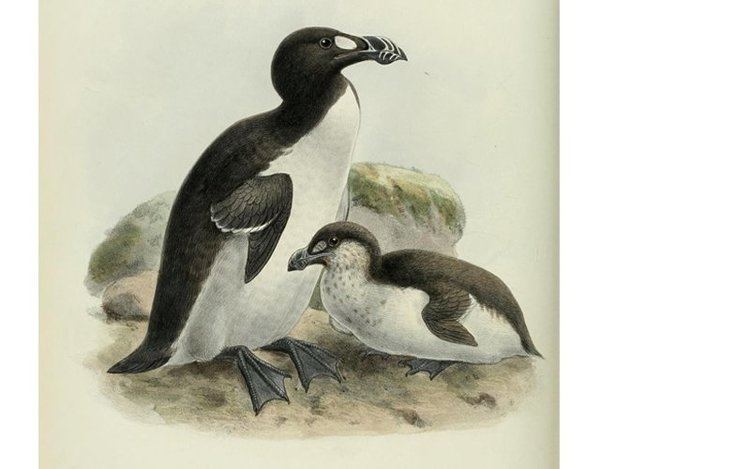 | ||
Genus †PinguinusBonnaterre, 1791 Similar Pinguinus, Auk, Passenger pigeon, Steller'S sea cow, Quagga | ||
The great auk by bahar c science project
The great auk (Pinguinus impennis) is a flightless bird of the alcid family that became extinct in the mid-19th century. It was the only modern species in the genus Pinguinus (unrelated to penguins, although it was the first bird to be called penguin). It bred on rocky, isolated islands with easy access to the ocean and a plentiful food supply, a rarity in nature that provided only a few breeding sites for the auks. When not breeding, the auks spent their Time foraging in the waters of the North Atlantic, ranging as far south as northern Spain and also around the coast of Canada, Greenland, Iceland, the Faroe Islands, Norway, Ireland, and Great Britain.
Contents
- The great auk by bahar c science project
- Scottish tv s item on the 200th anniversary of the great auk s extinction
- Taxonomy and evolution
- Etymology
- Description
- Distribution and habitat
- Ecology and behaviour
- Diet
- Reproduction
- Relationship with humans
- Extinction
- Preserved specimens
- Cultural depictions
- References
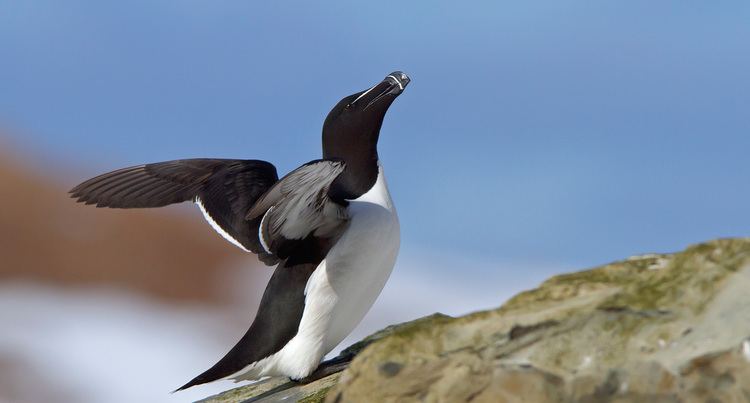
The great auk was 75 to 85 centimetres (30 to 33 in) tall and weighed around 5 kilograms (11 lb), making it the second-largest member of the alcid family (Miomancalla was larger). It had a black back and a white belly. The black beak was heavy and hooked, with grooves on its surface. During summer, the great auk's plumage showed a white patch over each eye. During winter, the auk lost these patches, instead developing a white band stretching between the eyes. The wings were only 15 centimetres (5.9 in) long, rendering the bird flightless. Instead, the auk was a powerful swimmer, a trait that it used in hunting. Its favourite prey were fish, including Atlantic menhaden and capelin, and crustaceans. Although agile in the water, it was clumsy on land. Great auk pairs mated for life. They nested in extremely dense and social colonies, laying one egg on bare rock. The egg was white with variable brown marbling. Both parents incubated the egg for about six weeks before the young hatched. The young auk left the nest site after two or three weeks, although the parents continued to care for it.
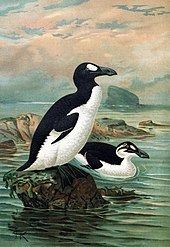
The great auk was an important part of many Native American cultures, both as a food source and as a symbolic item. Many Maritime Archaic people were buried with great auk bones, and one was buried covered in over 200 auk beaks, which are assumed to have been part of a cloak made of their skins. Early European explorers to the Americas used the auk as a convenient food source or as fishing bait, reducing its numbers. The bird's down was in high demand in Europe, a factor which largely eliminated the European populations by the mid-16th century. Scientists soon began to realize that the great auk was disappearing and it became the beneficiary of many early environmental laws, but this proved not to be enough. Its growing rarity increased interest from European museums and private collectors in obtaining skins and eggs of the bird. On 3 July 1844, the last two confirmed specimens were killed on Eldey, off the coast of Iceland, which also eliminated the last known breeding attempt. Later reports of roaming individuals being seen or caught are unconfirmed. A record of a bird in 1852 is considered by some to be the last sighting of the species. The great auk is mentioned in several novels and the scientific journal of the American Ornithologists' Union is named The Auk in honour of this bird.
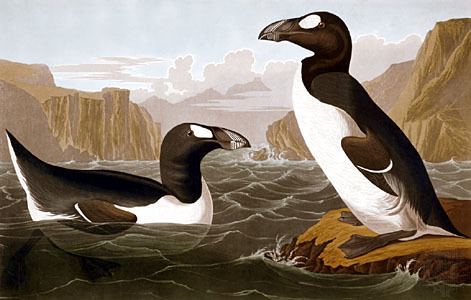
Scottish tv s item on the 200th anniversary of the great auk s extinction
Taxonomy and evolution
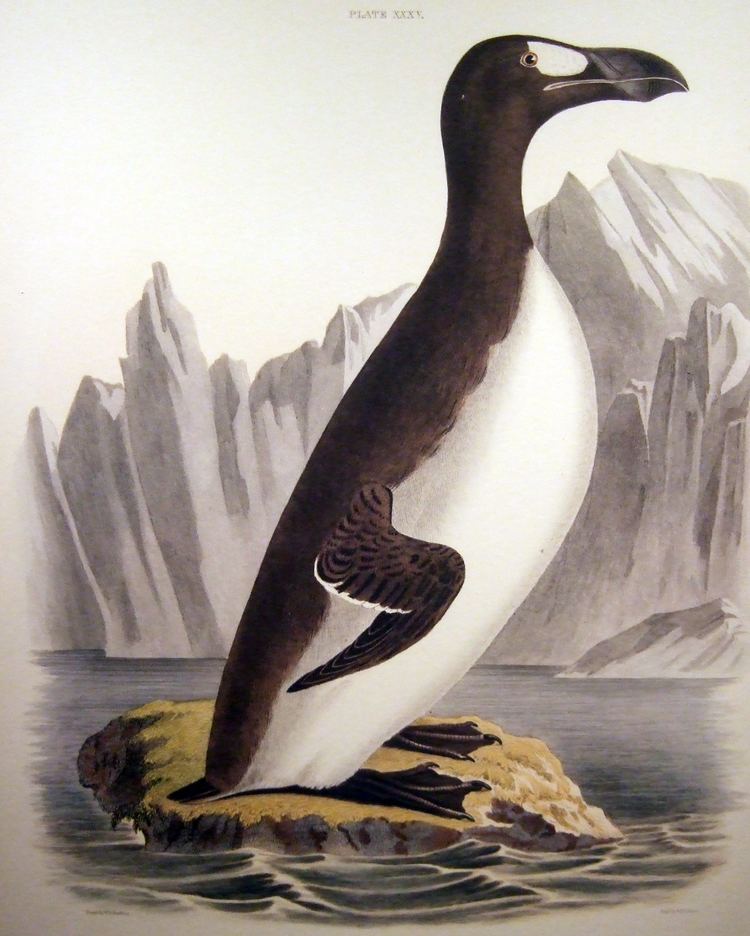
Analysis of mtDNA sequences has confirmed morphological and biogeographical studies suggesting that the razorbill is the great auk's closest living relative. The great auk was also closely related to the little auk (dovekie), which underwent a radically different evolution compared to Pinguinus. Due to its outward similarity to the razorbill (apart from flightlessness and size), the great auk was often placed in the genus Alca, following Linnaeus.

The fossil record (especially the sister species Pinguinus alfrednewtoni) and molecular evidence show that the three closely related genera diverged soon after their common ancestor, a bird probably similar to a stout Xantus's murrelet, had spread to the coasts of the Atlantic. By that time, the murres, or Atlantic guillemots, had apparently already split from the other Atlantic alcids. Razorbill-like birds were common in the Atlantic during the Pliocene, but the evolution of the little auk is sparsely documented. The molecular data are compatible with either view, but the weight of evidence suggests placing the great auk in a distinct genus. Some ornithologists still feel it is more appropriate to retain the species in the genus Alca. It is the only British bird made Extinct in historic times.
The following cladogram shows the placement of the great auk among its closest relatives, based on a 2004 genetic study:
Pinguinus alfrednewtoni was a larger and also flightless member of the genus Pinguinus that lived during the Early Pliocene. Known from bones found in the Yorktown Formation of the Lee Creek Mine in North Carolina, it is believed to have split along with the great auk from a common ancestor. Pinguinus alfrednewtoni lived in the western Atlantic while the great auk lived in the eastern Atlantic, but after the former died out after the Pliocene, the great auk replaced it. The great auk was not closely related to the other extinct genera of flightless alcids, Mancalla, Praemancalla, and Alcodes.
Etymology
The great auk was one of the 4,400 animal species originally described by Carl Linnaeus in his 18th-century work, Systema Naturae, in which it was named Alca impennis. The name Alca is a Latin derivative of the Scandinavian word for razorbills and their relatives. The species was not placed in its own genus, Pinguinus, until 1791. The generic name is derived from the Spanish and Portuguese name for the species, and the specific name impennis is from Latin and refers to the lack of flight feathers or pennae.
The Irish name for the great auk is 'falcóg mhór', meaning 'big seabird/auk'. The Basque name is arponaz, meaning "spearbill". Its early French name was apponatz. The Norse called the great auk geirfugl, which means "spearbird". This has led to an alternative English common name for the bird, "garefowl" or "gairfowl". The Inuit name for the great auk was isarukitsok, which meant "little wing". The word "penguin" first appears in the 16th century as a synonym for "great auk." It may be derived from the Welsh pen gwyn "white head", although the etymology is debated. When European explorers discovered what are today known as penguins in the Southern Hemisphere, they noticed their similar appearance to the great auk and named them after this bird, although they are not closely related. Whalers also lumped the northern and southern birds together under the common name woggins.
Description
Standing about 75 to 85 centimetres (30 to 33 in) tall and weighing around 5 kilograms (11 lb) as adult birds, the flightless great auk was the second-largest member of both its family and the order Charadriiformes, surpassed only by the mancalline Miomancalla. The auks that lived further north averaged larger in size than the more southerly members of the species. Males and females were similar in plumage, although there is evidence for differences in size, particularly in the bill and femur length. The back was primarily a glossy black, and the stomach was white. The neck and legs were short, and the head and wings small. The auk appeared chubby due to a thick layer of fat necessary for warmth. During summer, the great auk developed a wide white eye patch over the eye, which had a hazel or chestnut iris. During winter the auk moulted and lost this eye patch, which was replaced with a wide white band and a gray line of feathers which stretched from the eye to the ear. During the summer, the auk's chin and throat were blackish-brown, and the inside of the mouth was yellow. In winter, the throat became white. Some individuals had grey plumage on their flanks, but the purpose of this is unknown. The bill was large at 11 centimetres (4.3 in) long and curved downwards at the top; the bill also had deep white grooves in both the upper and lower mandibles, up to seven on the upper mandible and twelve on the lower mandible in summer, though there were fewer in winter. The wings were only 15 centimetres (5.9 in) in length and the longest wing feathers were only 10 centimetres (3.9 in) long. Its feet and short claws were black while the webbed skin between the toes was brownish black. The legs were far back on the bird's body, which gave it powerful swimming and diving abilities.
Hatchlings were grey and downy, but their exact appearance is unknown, since no skins exist today. Juvenile birds had less prominent grooves in their beaks and had mottled white and black necks, while the eye spot found in adults was not present; instead, a grey line ran through the eyes (which still had the white eye ring) to just below the ears.
The auk's calls included low croaking and a hoarse scream. A captive auk was observed making a gurgling noise when anxious. It is not known what its other vocalizations were like, but it is believed that they were similar to those of the razorbill, only louder and deeper.
Distribution and habitat
The great auk was found in the cold North Atlantic coastal waters along the coasts of Canada, the northeastern United States, Norway, Greenland, Iceland, the Faroe Islands, Ireland, Great Britain, France, and northern Spain. The great auk left the North Atlantic waters for land only to breed, even roosting at sea when not breeding. The rookeries of the great auk were found from Baffin Bay to the Gulf of St. Lawrence, across the far northern Atlantic, including Iceland, and in Norway and the British Isles in Europe. For their nesting colonies the great auks required rocky islands with sloping shorelines that provided access to the seashore. These were very limiting requirements and it is believed that the great auk never had more than 20 breeding colonies. The nesting sites also needed to be close to rich feeding areas and be far enough from the mainland to discourage visitation by humans and polar bears. The localities of only seven former breeding colonies are known: Papa Westray in the Orkney Islands, St Kilda off Scotland, Grimsey Island and Eldey Island and Geirfuglasker near Iceland, Funk Island near Newfoundland, and the Bird Rocks (Rochers-aux-Oiseaux) in the Gulf of St. Lawrence. Records suggest that this species may have bred on Cape Cod, Massachusetts. By the late 18th and early 19th centuries, the breeding range of the great auk was restricted to Funk Island, Grimsey Island, Eldey Island, the Gulf of St. Lawrence, and St Kilda Island. Funk Island was the largest known breeding colony.
The great auk migrated north and south away from the breeding colonies after the chicks fledged and tended to go southward during late autumn and winter. It was common on the Grand Banks of Newfoundland. In recorded history, the great auk typically did not go further south than Massachusetts Bay in the winter. Archeological excavations have found great auk remains as far as New England and Southern Spain. Great auk bones have been found as far south as Florida, where it may have occurred during four periods: around 1000 BC, 1000 AD, the 15th century, and the 17th century. (It has been suggested that some of the bones discovered in Florida may be the result of aboriginal trading.) Pleistocene fossils indicate the great auk inhabited Southern France, Italy and other coasts of the Mediterranean basin.
Ecology and behaviour
The great auk was never observed and described by modern scientists during its existence, and is only known from the accounts of laymen, such as sailors, so its behaviour is not well known and hard to reconstruct. Much can be inferred from its close, living relative, the razorbill, as well as from remaining soft tissue.
Great auks walked slowly and sometimes used their wings to help them traverse rough terrain. When they did run, it was awkwardly and with short steps in a straight line. They had few natural predators, mainly large marine mammals, such as the orca, and white-tailed eagles. Polar bears preyed on nesting colonies of the auk. This species had no innate fear of human beings, and their flightlessness and awkwardness on land compounded their vulnerability. They were hunted for food, for feathers, and as specimens for museums and private collections. Great auks reacted to noises, but were rarely scared by the sight of something. The auks used their bills aggressively both in the dense nesting sites and when threatened or captured by humans. These birds are believed to have had a life span of about 20 to 25 years. During the winter, the great auk migrated south either in pairs or in small groups, and never with the entire nesting colony.
The great auk was generally an excellent swimmer, using its wings to propel itself underwater. While swimming, the head was held up but the neck was drawn in. This species was capable of banking, veering, and turning underwater. The great auk was known to dive to depths of 76 metres (249 ft) and it has been claimed that the species was able to dive to depths of 1 kilometre (3,300 ft). To conserve energy, most dives were shallower. It could also hold its breath for 15 minutes, longer than a seal. Its ability to dive this deeply reduced competition with other alcid species. The great auk was capable of accelerating under water, then shooting out of the water to land on a rocky ledge above the ocean's surface.
Diet
This alcid typically fed in shoaling waters which were shallower than those frequented by other alcids, although after the breeding season they had been sighted up to 500 kilometres (310 mi) from land. They are believed to have fed cooperatively in flocks. Their main food was fish, usually 12 to 20 centimetres (4.7 to 7.9 in) in length and weighing 40 to 50 grams (1.4 to 1.8 oz), but occasionally their prey was up to half the bird's own length. Based on remains associated with great auk bones found on Funk Island and on ecological and morphological considerations, it seems that Atlantic menhaden and capelin were their favoured prey. Other fish suggested as potential prey include lumpsuckers, shorthorn sculpins, cod, crustaceans, and sand lance. The young of the great auk are believed to have eaten plankton and, possibly, fish and crustaceans regurgitated by adult auks.
Reproduction
Historical descriptions of the great auk's breeding behaviour are somewhat unreliable. Great auks began pairing in early and mid-May. They are believed to have mated for life, although some theorize that auks could have mated outside their pair, a trait seen in the razorbill. Once paired, they nested at the base of cliffs in colonies, where they likely copulated. Mated pairs had a social display in which they bobbed their heads, showing off their white eye patch, bill markings, and yellow mouth. These colonies were extremely crowded and dense, with some estimates stating that there was a nesting auk for every 1 square metre (11 sq ft) of land. These colonies were very social. When the colonies included other species of alcid, the great auks were dominant due to their size.
Female great auks would lay only one egg each year, between late May and early June, although they could lay a replacement egg if the first one was lost. In years when there was a shortage of food, the auk did not breed. A single egg was laid on bare ground up to 100 metres (330 ft) from shore. The egg was ovate and elongate in shape, and averaged 12.4 centimetres (4.9 in) in length and 7.6 centimetres (3.0 in) across at the widest point. The egg was yellowish white to light ochre with a varying pattern of black, brown or greyish spots and lines which often congregated on the large end. It is believed that the variation in the egg's streaks enabled the parents to recognize their egg in the colony. The pair took turns incubating the egg in an upright position for the 39 to 44 days before the egg hatched, typically in June, although eggs could be present at the colonies as late as August.
The parents also took turns feeding their chick. According to one account, the chick was covered with grey down. The young bird took only two or three weeks to mature enough to abandon the nest and land for the water, typically around the middle of July. The parents cared for their young after they fledged, and adults would be seen swimming with their young perched on their backs. Great auks sexually matured when they were four to seven years old.
Relationship with humans
The great auk was a food source for Neanderthals more than 100,000 years ago, as evidenced by well-cleaned bones found by their campfires. Images believed to depict the great auk were also carved into the walls of the El Pendo Cave, Santander in Spain over 35,000 years ago, and cave paintings 20,000 years old have been found in France's Grotte Cosquer.
Native Americans valued the great auk as a food source during the winter and as an important symbol. Images of the great auk have been found in bone necklaces. A person buried at the Maritime Archaic site at Port au Choix, Newfoundland, dating to about 2000 BC, was found surrounded by more than 200 great auk beaks, which are believed to have been part of a suit made from their skins, with the heads left attached as decoration. Nearly half of the bird bones found in graves at this site were of the great auk, suggesting that it had cultural significance for the Maritime Archaic people. The extinct Beothuks of Newfoundland made pudding out of the auk's eggs. The Dorset Eskimos also hunted it; the Saqqaq in Greenland overhunted the species, causing a local reduction in range.
Later, European sailors used the auks as a navigational beacon, as the presence of these birds signalled that the Grand Banks of Newfoundland were near.
This species is estimated to have had a maximum population in the millions. The great auk was hunted on a significant scale for food, eggs, and its down feathers from at least the 8th century. Prior to that, hunting by local natives can be documented from Late Stone Age Scandinavia and eastern North America, as well as from early 5th century Labrador, where the bird seems to have occurred only as a straggler. Early explorers, including Jacques Cartier and numerous ships attempting to find gold on Baffin Island, were not provisioned with food for the journey home, and therefore used this species as both a convenient food source and bait for fishing. Some of the later vessels anchored next to a colony and ran out planks to the land. The sailors then herded hundreds of these auks onto the ships, where they were slaughtered. Some authors have questioned whether this hunting method actually occurred successfully. Great auk eggs were also a valued food source, as the eggs were three times the size of a murre's and had a large yolk. These sailors also introduced rats onto the islands.
Extinction
The Little Ice Age may have reduced the population of the great auk by exposing more of their breeding islands to predation by polar bears, but massive exploitation for their down drastically reduced the population. By the mid-16th century, the nesting colonies along the European side of the Atlantic were nearly all eliminated by humans killing this bird for its down, which was used to make pillows. In 1553, the auk received its first official protection, and in 1794 Great Britain banned the killing of this species for its feathers. In St. John's, those violating a 1775 law banning hunting the great auk for its feathers or eggs were publicly flogged, though hunting for use as fishing bait was still permitted. On the North American side, eider down was initially preferred, but once the eiders were nearly driven to extinction in the 1770s, down collectors switched to the auk at the same time that hunting for food, fishing bait, and oil decreased.
The great auk had disappeared from Funk Island by 1800, and an account by Aaron Thomas of HMS Boston from 1794 described how the bird had been systematically slaughtered until then:
If you come for their Feathers you do not give yourself the trouble of killing them, but lay hold of one and pluck the best of the Feathers. You then turn the poor Penguin adrift, with his skin half naked and torn off, to perish at his leasure. This is not a very humane method but it is the common practize. While you abide on this island you are in the constant practize of horrid cruelties for you not only skin them Alive, but you burn them Alive also to cook their Bodies with. You take a kettle with you into which you put a Penguin or two, you kindle a fire under it, and this fire is absolutely made of the unfortunate Penguins themselves. Their bodys being oily soon produce a Flame; there is no wood on the island.
With its increasing rarity, specimens of the great auk and its eggs became collectible and highly prized by rich Europeans, and the loss of a large number of its eggs to collection contributed to the demise of the species. Eggers, individuals who visited the nesting sites of the great auk to collect their eggs, quickly realized that the birds did not all lay their eggs on the same day, so they could make return visits to the same breeding colony. Eggers only collected eggs without embryos growing inside them and typically discarded the eggs with embryos.
On the islet of Stac an Armin, St Kilda, Scotland, in July 1840, the last great auk seen in Britain was caught and killed. Three men from St Kilda caught a single "garefowl", noticing its little wings and the large white spot on its head. They tied it up and kept it alive for three days, until a large storm arose. Believing that the auk was a witch and the cause of the storm, they then killed it by beating it with a stick.
The last colony of great auks lived on Geirfuglasker (the "Great Auk Rock") off Iceland. This islet was a volcanic rock surrounded by cliffs which made it inaccessible to humans, but in 1830 the islet submerged after a volcanic eruption, and the birds moved to the nearby island of Eldey, which was accessible from a single side. When the colony was initially discovered in 1835, nearly fifty birds were present. Museums, desiring the skins of the auk for preservation and display, quickly began collecting birds from the colony. The last pair, found incubating an egg, was killed there on 3 July 1844, on request from a merchant who wanted specimens, with JóN Brandsson and Sigurður Ísleifsson strangling the adults and Ketill Ketilsson smashing the egg with his boot.
Great auk specialist John Wolley interviewed the two men who killed the last birds, and Sigurður described the act as follows:
The rocks were covered with blackbirds [referring to Guillemots] and there were the Geirfugles ... They walked slowly. Jón Brandsson crept up with his arms open. The bird that Jón got went into a corner but [mine] was going to the edge of the cliff. It walked like a man ... but moved its feet quickly. [I] caught it close to the edge – a precipice many fathoms deep. Its wings lay close to the sides - not hanging out. I took him by the neck and he flapped his wings. He made no cry. I strangled him.
A later claim of a live individual sighted in 1852 on the Grand Banks of Newfoundland has been accepted by the International Union for Conservation of Nature and Natural Resources (IUCN).
Preserved specimens
Today, 78 skins of the great auk remain mostly in museum collections, along with around 75 eggs and 24 complete skeletons. All but four of the surviving skins are in summer plumage, and only two of these are immature. No hatchling specimens exist. Each egg and skin has been assigned a number by specialists. Though thousands of isolated bones were collected from 19th century Funk Island to Neolithic middens, only a few complete skeletons exist. Natural mummies are also known from Funk Island, and the eyes and internal organs of the last two birds from 1844 are stored in the Zoological Museum, Copenhagen. It is uncertain where their skins are located today, but according to Errol Fuller, three are suspected due to their connection to a specific dealer in Copenhagen; the specimens in Los Angeles County Museum of Natural History, in the Royal Belgian Institute of Natural Sciences, and the one in Übersee-Museum Bremen.
Following the bird's extinction, remains of the great auk increased dramatically in value, and auctions of specimens created intense interest in Victorian Britain, where 15 specimens are now located, the largest number of any country. A specimen was bought in 1971 by the Icelandic Museum of National History for £9000, which placed it in the Guinness Book of Records as the most expensive stuffed bird ever sold. The price of its eggs sometimes reached up to 11 times the amount earned by a skilled worker in a year. The present whereabouts of six of the eggs are unknown, and several other eggs have been accidentally destroyed. Two mounted skins were destroyed in the 20th century, one in the Mainz Museum during the Second World War, and one in the Museu Bocage, Lisbon, was destroyed by a fire in 1978.
Cultural depictions
The great auk is one of the more frequently referenced extinct birds in literature, much like the famous dodo. It appears in many works of children's literature. Charles Kingsley's The Water-Babies, A Fairy Tale for a Land Baby depicts a great auk telling the tale of its species' extinction. (In this image, Kingsley's artist played with or misunderstood the words "large pair of white spectacles", intended to mean the natural white patches on the bird's face.) Enid Blyton's The Island of Adventure features the bird's extinction, sending the protagonist on a failed search for what he believes is a lost colony of the species.
The great auk is also present in a wide variety of other works of fiction. In the short story The Harbor-Master, by Robert W. Chambers, the discovery and attempted recovery of the last known pair of great auks is central to the plot (which also involves a proto-H.P. Lovecraftian element of suspense). The story first appeared in Ainslee's Magazine (Aug 1889) and was slightly revised to become the first five chapters of Chambers'episodic novel In Search of the Unknown, (Harper and Brothers Publishers, New York, 1904). In his novel Ulysses, James Joyce mentions the bird while the novel's main character is drifting into sleep. He associates the great auk with the mythical roc as a method of formally returning the main character to a sleepy land of fantasy and memory. Penguin Island, a 1908 French satirical novel by the Nobel Prize winning author Anatole France, narrates the fictional history of a great auk population that is mistakenly baptized by a nearsighted missionary. A great auk is collected by fictional naturalist Stephen Maturin in the Patrick O'Brian historical novel The Surgeon's Mate. This work also details the harvesting of a colony of auks. The great auk is the subject of a novel, The Last Great Auk by Allen Eckert, which tells of the events leading to the extinction of the great auk as seen from the perspective of the last one alive. The bird also appears in Farley Mowat's Sea of Slaughter.
This bird is also featured in a variety of other media. It is the subject of a ballet, Still Life at the Penguin Café, and a song, "A Dream Too Far", in the ecological musical Rockford's Rock Opera. A great auk appears as a prized possession of Baba the Turk in Igor Stravinsky's opera The Rake's Progress (libretto by W. H. Auden and Chester Kallman). The great auk is the mascot of the Archmere Academy in Claymont, Delaware, Sir Sandford Fleming College in Ontario, and the Adelaide University Choral Society (AUCS) in Australia. It is also the mascot of the Knowledge Masters educational competition. The scientific journal of the American Ornithologists' Union is named The Auk in honour of this bird. According to Homer Hickam's memoir, Rocket Boys, and its film production, October Sky, the early rockets he and his friends built were ironically named "Auk". A cigarette company, the British Great Auk Cigarettes, was named after this bird. Walton Ford, the American painter, has featured great auks in two paintings: "The Witch of St. Kilda" and "Funk Island". The English painter and writer Errol Fuller produced "Last Stand" for his monograph on the species. The great auk also appeared on one stamp in a set of five depicting extinct birds issued by Cuba in 1974. Ogden Nash warns that humans could suffer the same fate as the great auk in his short poem "A Caution to Everybody."
